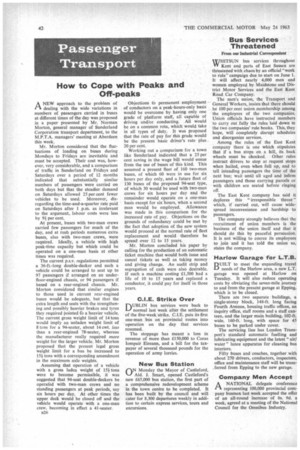How to Cope with Peaks and Off-peaks
Page 44

If you've noticed an error in this article please click here to report it so we can fix it.
ANEW approach to the problem of dealing with the wide variations in numbers of passengers carried in buses at different times of the day was proposed in a paper presented by Mr. Norman Morton, general manager of Sunderland Corporation transport department, to the M.P.T.A. managers' meeting at Aberdeen this week.
Mr. Morton considered that the fluctuations of loading on buses during Mondays to Fridays are inevitable and must be accepted. Their cost was, however, very considerable, and a comparison of traffic in Sunderland on Fridays and Saturdays over a period of 12 months indicated that substantially similar numbers of passengers were carried on both days but that the steadier demand on Saturdays allowed 25 per cent fewer vehicles to be used. Moreover, disregarding the time-and-a-quarter rate paid on Saturdays after 1 p.m. as irrelevant to the argument, labour costs were less by 9+ per cent.
At present, buses with two-man crews carried few passengers for much of the day, and at rush periods numerous extra buses, also with two-man crews, were required. Ideally, a vehicle with high peak-time capacity but which could be operated on a one-man basis at other times was required.
The current p.s.v. regulations permitted a 36-ft.-long double-decker and such a vehicle could be arranged to seat up to 97 passengers if arranged on an underfloor-engined chassis, or 94 passengers if based on a rear-engined chassis. Mr. Morton Considered that similar engines to those used in current rear-engined buses would be adequate, but that the extra length and seats with the strengthening and possibly heavier brakes and tyres they required pointed fo a heavier vehicle. The current gross weight limit of 14 tons would imply an unladen weight limit of 8 tons for a 94-seater, about 14 cwt. less than a rear-engined 78-seater, whereas the manufacturer really required more weight for the larger vehicle. Mr. Morton proposed that the present legal gross weight limit for a bus be increased to 151 tons with a corresponding amendment in the maximum axle weights.
Assuming that operation of a vehicle with a gross laden weight of 151 tons were to become permissible, it was suggested that 94-seat double-deckers be operated with two-man crews and no standing passengers at peak periods, say six hours per day. At other times the upper deck would be closed off and the vehicle would operate with a one-man crew, becoming in effect a 41-seater.
n26
Objections to permanent employment of conductors on a peak-hours-only basis would be overcome by having only one grade of platform staff, all capable of driving and/or conducting. All would be on a common rota, which would take in all types of duty. It was proposed that the rate of pay for this grade would be the present basic driver's rate plus. 20 per cent.
Working out a comparison for a town like Sunderland indicated that a 25 per cent saving in the wage bill would ensue from the use of buses of this kind. This assumed a present fleet of 160 two-man buses, of which 60 were in use for six hours per day only, and a future fleet of 130 buses of the proposed 94-seat type, of which 30 would be used with two-man crews for six hours per day and the remainder would operate on a one-man basis except for six hours, when a second man would be employed. Allowance was made in this comparison for the increased rate of pay. Objections on the grounds of redundancy could be met by the fact that adoption of the new system would proceed at the normal rate of fleet replacement and would therefore be spread over 12 to 15 years.
Mr. Morton concluded his paper by calling for the production of an automatic ticket machine that would both issue and cancel tickets as well as taking money and giving change. An audit strip and segregation of cash were also desirable. If such a machine costing 1.1,500 had a life of 10 to 15 years and replaced a conductor, it could pay for itself in three years.
C.I.E. Strike Over DUBLIN bus services were back to normal last week after the settlement of the five-week strike. C.I.E. puts its first one-man bus on provincial routes into operation on the day that services resumed.
The stoppage has meant a loss in revenue of more than £150,000 to Coras Iompair Eireann, and a bill for the taxpayer of several thousand pounds for the operation of army lorries.
New Bus Station nN Monday the Mayor of Castleford, Ald. J. Smart, opened Castleford's new £65,000 bus station, the first part of a comprehensive redevelopment scheme in the town centre to be completed. It has been built by the council and will cater for 8,300 departures weekly in addition to certain express services, tours and excursions.
















































































































